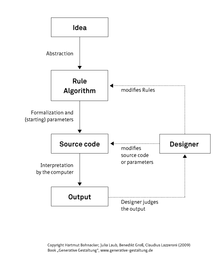Generative Design

Generative design is a technology that mimics nature’s evolutionary approach to design. It starts with your design goals and then explores all of the possible permutations of a solution to find the best option. Using cloud computing, generative design software quickly cycles through thousands—or even millions—of design choices, testing configurations and learning from each iteration what works and what doesn’t. The process lets designers generate brand new options, beyond what a human alone could create, to arrive at the most effective design.[1]
Most generative design, in which the output could be images, sounds, architectural models, animation etc., is based on parametric modeling. It is a fast method of exploring design possibilities that is used in various design fields such as Art, Architecture, Communication Design, and Product Design. Typically, generative design has:
- A design schema
- A means of creating variations
- A means of selecting desirable outcomes
Some generative schemes use genetic algorithms to create variations. Some use just random numbers. Generative design has been inspired by natural design processes, whereby designs are developed as genetic variations through mutation and crossovers. In contrast to long-established concepts such as Generative Art or Computer Art, Generative Design also includes particular tasks within the area of design, architecture, and product design.
Within the Communication Design area, the main applications are the creation of information graphics, diagrams, and flexible corporate designs. Generative design in architecture (also often referred to as computational design) is mainly applied for form-finding processes and for the simulation of architectural structures.
Generative design is becoming more important, largely due to new programming environments (Processing, Vvvv, Quartz Composer, Open Frameworks) or scripting capabilities ( Grasshopper 3D in Rhinoceros 3D, Scriptographer) that have made it relatively easy, even for designers with little programming experience, to implement their ideas.But it can also be related with data driven architecture. Parametric architecture includes both program generated and data-driven software.
Generative design is taught at many schools of architecture and is gaining ground in architectural and design practice.
Definition by Celestino Soddu, 1992: "Generative Design is a morphogenetic process using algorithms structured as non-linear systems for endless unique and unrepeatable results performed by an idea-code, as in Nature"
Definition by Sivam Krish 2013: " Generative Design is the transformation of computational energy into creative exploration energy empowering human designers to explore greater number of design possibilities within modifiable constrains"
One of the most important and distinguishing parts that making a computational model generative is the feedback loop. The feedback ranges from simple mechanisms, where the model takes its own output for input, to relatively complex ones incorporating design evaluation routines. Generative methods have their roots deep in the system dynamics modelling and are by nature repetitive processes where the solution is developed during several iterations of design operations.
References
- ↑ "WHAT IS GENERATIVE DESIGN?". Autodesk, Inc. Retrieved 3 July 2016.
- Gary William Flake: The Computational Beauty of Nature: Computer Explorations of Fractals, Chaos, Complex Systems, and Adaptation. MIT Press 1998, ISBN 978-0-262-56127-3
- John Maeda: Design by Numbers, MIT Press 2001, ISBN 978-0-262-63244-7
- Celestino Soddu: papers on Generative Design (1991-2011) at http://www.argenia.it/papers.html
- http://reneepuusepp.com/what-is-generative-design/